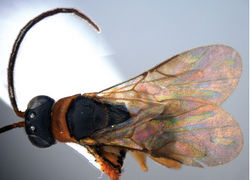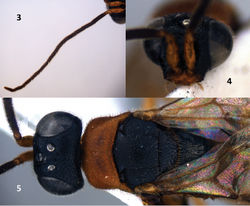Imasega bicolor
| Notice: | This page is derived from the original publication listed below, whose author(s) should always be credited. Further contributors may edit and improve the content of this page and, consequently, need to be credited as well (see page history). Any assessment of factual correctness requires a careful review of the original article as well as of subsequent contributions.
If you are uncertain whether your planned contribution is correct or not, we suggest that you use the associated discussion page instead of editing the page directly. This page should be cited as follows (rationale):
Citation formats to copy and paste
BibTeX: @article{Li2017JournalofHymenopteraResearch, RIS/ Endnote: TY - JOUR Wikipedia/ Citizendium: <ref name="Li2017Journal of Hymenoptera Research">{{Citation See also the citation download page at the journal. |
Ordo: Hymenoptera
Familia: Chrysididae
Genus: Imasega
Name
Imasega bicolor Li & Xu sp. n. – Wikispecies link – ZooBank link – Pensoft Profile
Material examined
Holotype ♂, CHINA: Guangdong, Fengkai, Heishiding Provincial Nature Reserve, 1.X.2003, leg. Ju-jian Chen, No. 20047672 (SCAU). Paratypes: 1♂, CHINA: Guangdong, Fengkai, Heishiding Provincial Nature Reserve, 1.X.2003, leg. Ju-jian Chen, No. 20047664 (SCAU); 1♂, CHINA: Guangdong, Fengkai, Heishiding Provincial Nature Reserve, 1.X.2003, leg. Ju-jian Chen, No. 20047642 (SCAU); 1♂, CHINA: Guangdong, Longmen, Nankunshan Provincial Nature Reserve, 2–3.V.2005, leg. Zai-fu Xu, No. 200509614 (SCAU).
Description
Holotype. Male. Body length 3.6 mm. Forewing length 2.8 mm. MOL = 2.0 MOD; OOL = 0.8 MOD; POL = 1.7 MOD; MS = 1.7 MOD. Relative length of S:F1:F2:F3 = 1.5:1.6:1.2:1.1.
Head. Head with setulae. Head 1.4 × as wide as distance from clypeal apex to posterior ocelli. Head (except scapal basin) punctate; punctures interspaced by 0.2–1.0 PD. Scapal basin slightly concave, with faint transverse rugulae and smooth longitudinal median ridge. Eye strongly bulging and with dense, erect setulae. Clypeal apex thickened. Mandible with one tooth. MS less than half of eye height. Ocellar triangle obtuse isosceles. Flagellum with dense, oblique setulae; flagellar setulae about half as long as width of flagellar segment; F1 4.5 × as long as wide; F2 3.4 × as long as wide; F3 3.4 × as long as wide; F4 3.7 × as long as wide; F5 3.8 × as long as wide; F6 4.2 × as long as wide; F7 4.3 × as long as wide; F8 4.4 × as long as wide. Occipital carina absent.
Mesosoma. Mesosoma with setulae. Pronotum punctate; punctures interspaced by 0.3–0.6 PD; pronotum with longitudinal median groove on posterior third; pronotum 0.8 × as long as mesoscutum medially; Mesoscutum punctate; punctures interspaced by 0.3–0.6 PD. Notauli incomplete, present posteriorly. Parapsidal lines weakly impressed. Mesoscutellum punctate. Mesopleuron punctate, without scrobal sulcus or omaulus; punctures interspaced by 0.1–0.7 PD. Metanotum punctate, medially 0.8 × as long as mesoscutellum, with triangular median enclosure 0.8 × as long as basal width. Metapleuron mostly smooth. Propodeum with short and blunt posterolateral teeth; posterior and lateral surfaces weakly rugose. Hind coxa without dorsobasal carina. Tarsal claw with large median tooth.
Metasoma. Metasoma with setulae. Metasomal tergites and sternites finely and sparsely punctate; punctures interspaced by 3.0 to 10.0 PD.
Colouration. Body without metallic reflection. Head black. Antenna blackish brown, with scape and pedicel yellowish brown. Mandible yellowish brown, with tooth reddish brown. Clypeus yellowish brown. Pronotum and propleuron yellowish brown. Mesoscutum, mesoscutellum, metanotum and propodeum black. Mesopleuron black, with upper area brown. Metapleuron black. Legs with coxae and trochanters whitish yellow, femora, tibiae and tarsi yellowish brown. Wings hyaline, with stigma and veins brown.
Variations. Paratypes. Body length 3.4–4.1 mm. Head 1.4–1.7 × as wide as distance from clypeal apex to posterior ocelli. F4–F8 3.7–4.4 × as long as wide. Pronotum 0.7–1.0 × as long as mesoscutum medially. Metanotum 0.8–1.1 × as long as mesoscutellum medially.
Female. Unknown.
Biology
Unknown.
Distribution
China (Guangdong).
Etymology
The specific name “bicolor” refers to the colouration of the mesosoma.
Original Description
- Li, S; Xu, Z; 2017: First record of Imasega Krombein from China, with description of one new species (Hymenoptera, Chrysididae, Amiseginae) Journal of Hymenoptera Research, (54): 71-77. doi
Images
|


